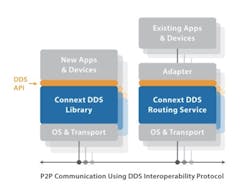Connectivity Software for IoT Data Sharing
The crux of any Internet of Things (IoT) application is seamless data sharing. It is the complexity of such data sharing in industrial environments—with decades of legacy devices systems using different communications protocols—that presents the toughest industrial IoT challenges. This industrial data sharing complexity is often the principal factor that halts many IoT projects before they get started.
That’s why there has been so much focus on data integration connectivity standards like the OPC Foundation’s OPC-UA (Unified Architecture) and the Industrial Internet Consortium’s DDS (Data Distribution Service). Even with the advent of these standards, however, the industrial environment is still far from achieving plug-and-play capability between devices and systems.
Real-Time Innovations’ (RTI) work in this area is aimed at helping industry move closer to easier data sharing. RTI’s Connext databus is a software framework that, according to RTI, shares information across field, fog and cloud in real time to enable applications to work together as one integrated system.
Based on theIndustrial Internet Consortium (IIC)’s Industrial Internet Reference Architecture(IIRA), which identifies a layered databus pattern as the recommended framework for developing multi-tiered industrial IoT systems of systems, RTI says its newly released Connext DDS 5.3 is the first connectivity software designed to implement the IIRA’s layered databus pattern while also fostering interoperability and an open architecture.
David Barnett, vice president of products and markets at RTI, said, “With the introduction of Connext DDS 5.3, we are making it easier for developers to ensure their systems can handle the complex performance and scalability requirements of the IIoT while integrating the level of security necessary for critical applications.”
Since much of RTI’s release referenced use of Connext DDS 5.3’s use by developers, I asked Brett Murphy, director of business development at RTI, to explain the type of developers RTI has in mind for Connext DDS 5.3. Murphy said the main customers for DDS Connext are OEMs and system integrators in the industrial automation space who use the software to “help integrate the next level of software systems and automation needs of next generation industrial automation systems. For example, we have customers looking to replace their ‘walled-garden’ connectivity standard for control data distribution using DDS. Other customers in manufacturing are using it to closely integrate robotics across a factory with low-latency, software heavy automation.”
Murphy pointed to applications by National Oilwell Varco, which has used Connext DDS to develop an automation system, and the US Army Corp of Engineers, which has moved beyond its old SCADA system controlling the Grand Coulee Dam to a more open, scalable and extensible control system based on DDS.
A key aspect of Connext DDS 5.3’s capabilities is its ability to manage historical data queries. Barnett noted that “IIoT applications often need access to historical data to refine analytics or update dashboards. However, due to the large amount of data in IIoT systems of systems, it is rarely possible to send all data to all locations. Connext DDS 5.3 provides the capability to request and receive historical data as efficiently as live data” as well as the ability to filter data for specific content without flooding network bandwidth.
Since DDS is a relatively new standard, I asked Murphy to explain how Connext handles integration with other systems. “The IIC's Industrial Internet Connectivity Framework architecture recommends selecting a core integration connectivity standard, like DDS or OPC-UA,” he said. “It also recommends bridging other legacy subsystem protocols into the core protocol. This helps ensure a common integration point and better security as all communications pass through the core bus. In Connext DDS 5.3, we include the Gateway Toolkit, which has proven to simplify the bridging of protocols and data models into DDS as the core databus for the system.”
Murphy added that DDS, as a standard, has been around since 2004. “RTI alone has over 1,000 customer designs and deployments of our Connext DDS and we estimate there are at least another 1,000 deployments using other DDS implementations,” he said. “We would also estimate at least 75 percent of those deployments integrate devices that are either using analog inputs/outputs, sensor net protocols, or other control protocols. In most cases our OEM and system integrator customers have developed integrations on their own as the DDS API. In some cases, DDS vendors offer off-the-shelf integrations with other protocols such as Modbus, DNP-3, and MQTT. RTI supports these as well.”

